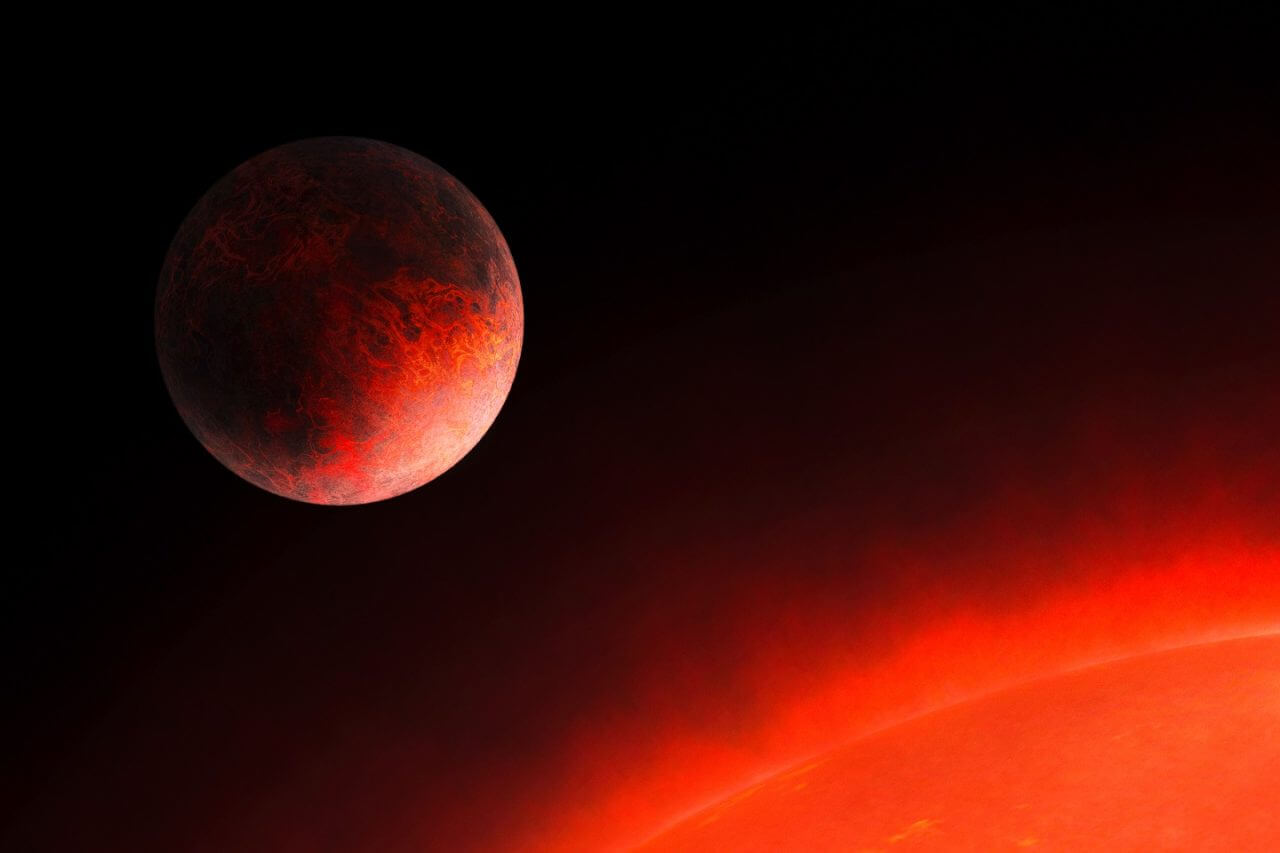A research team led by Elisa Goffo, a doctoral student at the University of Turin, has discovered that the average density of the exoplanet GJ 367b (Gliese 367b), located approximately 31 light-years away in the constellation Vela, is 1 cube. The results show that it is about 10.2 grams per cm. This value is 1.85 times Earth’s average density (5.51 g per cubic centimeter), indicating the possibility that GJ 367b is made primarily of iron. A paper summarizing the research team’s findings has been published in The Astrophysical Journal Letters.
[▲انطباعالفنانعنالكوكبالخارجي”GJ367b”(يسار)(مصدرالصورة:DLR/SPP1992(باتريشياكلاين))]
GJ 367b is an exoplanet reported to have been discovered in 2021 based on observational data from NASA’s TESS Exoplanet Exploration Satellite (Gliese 367, the radius is about 0.458 times and the mass is about 0.455 times (the Sun), the average is about 0.007 astronomical units(※)It rotates at a distance of about 7.7 hours, and its surface temperature is estimated at about 1100 degrees Celsius. Planets like GJ 367b, whose orbital period is less than one day, are also called very short period planets (UPS).
*…1 astronomical unit (au) = about 150 million kilometers, derived from the average distance from the Sun to Earth. 0.007 astronomical units = about 1.05 million kilometers, which is about 1/55 of the average distance from the Sun to Mercury.
The star system GJ 367 was chosen as a naming target for the International Astronomical Union’s (IAU) exoplanet naming campaign in 2022, and GJ 367b, discovered at the time of the campaign, was named “Tahay”, the main name. The star GJ 367 is called “Añañuca”.
Related: Names selected for 2022 Exoplanet Naming Campaign announced 7 of 20 star systems derived from indigenous languages (June 12, 2023)
According to the research team, GJ 367b has a radius of about 0.699 times that of Earth, and its mass is about 0.633 times that of Earth. The average density derived from this is about 10.2 g per cubic centimeter as stated above. To accurately measure the mass of GJ 367b, the research team used the High Resolution Radial Velocity Exoplanet Survey (HARPS), attached to the European Southern Observatory’s (ESO) 3.6-meter telescope at La Silla Observatory (Chile). The radial velocity method (described later) using the high-resolution radial velocity planet finder.
The research team that analyzed the internal structure of GJ 367b believes that the iron core represents about 91% of its total mass. Of the more than 5,500 exoplanets discovered so far, there is rarely one with such a high average density, and Jovo believes that GJ 367b may have originally formed in an iron-rich environment, or that GJ 367b may have formed in an iron-rich environment. With iron. They mention the possibility that the rocky mantle that surrounded the iron core was later stripped away.
RELATED: ‘Incredibly’ dense planet ‘TOI-1853b’ discovered (September 10, 2023)
In addition, as a result of observations with the ESO 3.6m telescope, the research team discovered two new planets, GJ 367c and GJ 367d, which had not been detected by TESS observations using the transit method (described later). The minimum mass of GJ 367c is about 4.13 times that of Earth, GJ 367d is about 6.03 times that of Earth, and the orbital period is about 11.5 days for GJ 367c and about 34.4 days for GJ 367d. The research team believes that this planetary system, which includes the small and dense planet GJ 367b, is an ideal target for further research into the formation and migration of very short-period planets.
■Typical methods for exploring exoplanets: “transit method” and “radial velocity method”
Two methods are mainly used to observe exoplanets: the “transit method” and the “radial velocity method (Doppler shift method).”
The “transit method” is an indirect method for detecting exoplanets based on the slight changes in the brightness of the host star that occur when an exoplanet crosses in front of its host star (transit). This is a detection method
By observing repeated transits, we can determine the orbital period of an exoplanet by its period. It is also possible to obtain information such as the diameter of an exoplanet and the presence or absence of an atmosphere based on the light curve of the host star at the time of the transit (a curve showing the brightness of a celestial body as it changes over time).
[▲ فيديو يوضح كيف يتغير سطوع النجم بسبب عبور كوكب خارج المجموعة الشمسية]
(Credit: iso/l.way)
Another method, the radial velocity method (Doppler shift method), detects exoplanets indirectly based on the motion of the host star, which vibrates slightly in a circular motion as the exoplanet rotates. It’s a way.
As the host star vibrates as the planet rotates, the color of the light changes periodically, from blue when the host star moves toward Earth to reddish when it moves away from Earth. These changes in the color of the host star are detected through spectroscopic observations that obtain the spectrum (the strength of electromagnetic waves at each wavelength) of the astronomical object. The orbital period and minimum exoplanet mass can be determined from observational data obtained using the radial velocity method.
[▲ فيديو يوضح كيف يتغير طيف النجم المضيف مع دوران الكوكب الخارجي]
(Credit: iso/l.way)
source
- University of Turin – An iron-core planet in an extrasolar system: The discovery made by a team from the University of Turin adds to the puzzle of how planets form
- Gofo et al. – Very High Density, Very Short Period Underground GJ 367 b: Two additional low-mass planets discovered at 11.5 and 34 days (The Astrophysical Journal Letters)
Text Editing/Syrian Studies Department

“Travel maven. Beer expert. Subtly charming alcohol fan. Internet junkie. Avid bacon scholar.”

![[معلومات Mac]Share passwords with your family and friends with macOS Sonoma's new Shared Password Sets feature! – Watch the computer](https://pc.watch.impress.co.jp/img/pcw/list/1587/545/fig13.png)




More Stories
[معلومات Mac]Share passwords with your family and friends with macOS Sonoma's new Shared Password Sets feature! – Watch the computer
Time lapse of the Crab Nebula and Cassiopeia A supernova remnants seen by the X-ray space telescope | Universe Gate website
The Alexa-equipped smart display “Echo Show 5” is compact but has many functions | Gizmodo Japan